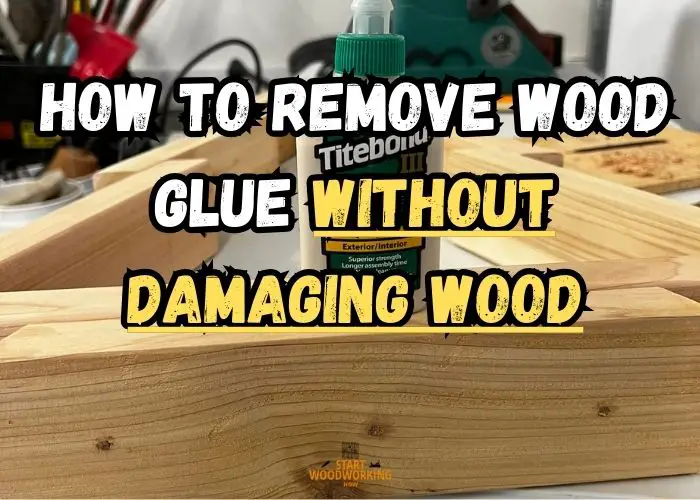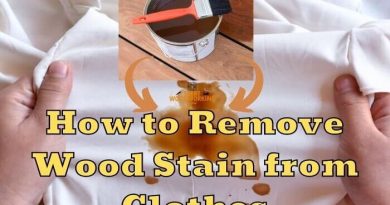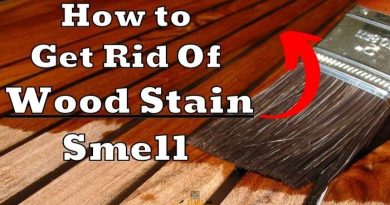How to Remove Wood Glue Without Damaging Wood [Best Methods]
Wood glue is a widely used adhesive in woodworking projects, with its strong bonding capabilities and durability. However, it can be challenging to remove wood glue from wood surfaces without causing damage.
Follow along as we discuss these methods and provide valuable tips to preserve the integrity of your wood furniture and projects.
Best Removal Methods Based on Wood Glue Type
| Wood Glue Type | Bonding Strength | Key Properties | Best Removal Method |
|---|---|---|---|
| White PVA Glue | Medium | Water-resistant, non-toxic, dries clear | Sanding or heat application |
| Yellow PVA Glue (Aliphatic resin) | High | Water-resistant, gap-filling, dries fast | Sanding or heat application |
| Epoxy | Very High | Waterproof, temperature-resistant, fills gaps | Heat application or solvent use |
| Polyurethane Glue | Very High | Waterproof, versatile, structural bonding | Heat application or solvent use |
Pre-treatment Steps Before Attempting Glue Removal
Before diving into wood glue removal hacks, it’s crucial to prepare your work area and materials to prevent unnecessary damage to the wood. Here’s a simple guide to preparing for glue removal and achieving a gentle wood glue removal process:
- Identify the type of wood and finish you are dealing with. This helps choose the appropriate adhesive removal method, tools, and products.
- Ensure that the workspace is clean, clutter-free, and well-ventilated to avoid accidental spills or accidents during the removal process.
- If dealing with finished wood, conduct a pre-test in an inconspicuous area to ensure that the removal agent, heat application, or mechanical force will not discolor or damage the wood surface.
Method 1: Remove Wood Glue using Heat Without Damaging the Wood
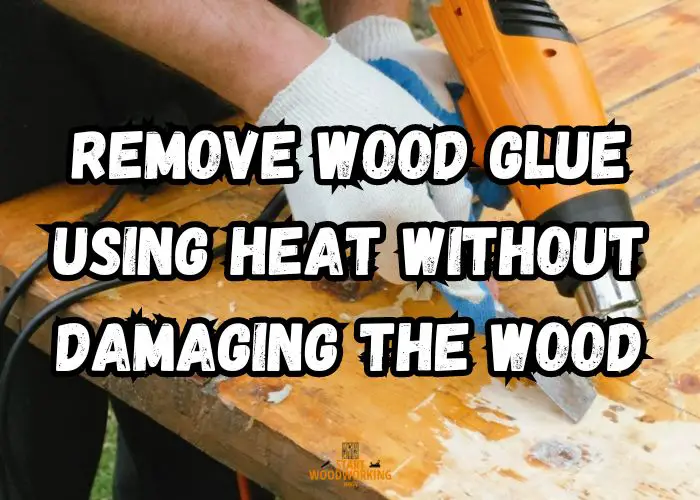
For finished wood surfaces, using a heat application method to soften wood glue before removal is recommended. The careful and controlled application of heat ensures that the wood’s finish remains intact while making the adhesive pliable enough to be removed with minimal effort.
Tools Required
- Hairdryer or Heat Gun: For the controlled application of heat to soften wood glue.
- Plastic Scraper or Putty Knife: Gently lifts and removes adhesive without harming the wood’s finish.
- Soft Cloth: Dampened in warm, soapy water to clean residual glue.
Here are step-by-step instructions for removing wood glue with heat without damaging the wood:
- Protect your work surface from heat damage and have good ventilation. An outdoor space is best.
- Use a heat gun or hair dryer on the lowest heat setting. Test the heat on scrap wood first to avoid scorching.
- Direct the stream of heated air onto the glue line at a 6-12 inch distance. Don’t focus the heat in one spot for more than 3-5 seconds.
- Move the hairdryer or heat gun over the area with dried glue in a consistent, back-and-forth motion for a few minutes until you notice the glue starting to soften.
- The glue should soften and change color as it heats. This usually takes 30-60 seconds per glue line depending on thickness.
- Once the glue is softened, use a plastic scraper or putty knife to gently lift and remove the adhesive without damaging the wood’s finish
- Work in small sections and reapply heat as needed to prevent the glue from hardening before complete removal.
- For tight spots, use the heat gun to soften the glue then use a toothpick or awl to scrape or pick it out.
- Check for any remaining residue and re-apply heat to fully remove it from the wood pores.
- Allow the wood to fully cool before sanding with 150-grit paper to smooth out any rough areas from scraping.
- Wipe away dust and inspect your work. Reapply heat if needed before finishing or reassembly.
It is important to remember that patience and caution are key during heat application for finished wood. Rushing the process or using excess heat may cause unintended damage to the wood’s surface, counteracting the benefits of using a heat treatment.
For a visual comparison of different heat application scenarios and their potential effects on the wood glue removal process, refer to the following table:
| Heat Gun Setting | Distance from Surface | Duration of Heat Application | Impact on Wood Finish | Effectiveness on Glue Softening |
|---|---|---|---|---|
| Low | 3-4 inches | 2-3 minutes | Minimal risk | Effective |
| Medium | 4-5 inches | 1-2 minutes | Low risk | Effective |
| High | 6-8 inches | Not recommended | Higher risk | Less effective, may burn or bubble glue |
Method 2: Removing Wood Glue with Acetone Without Causing Damage
Tools Required
- Acetone: Powerful solvent for breaking the glue bond.
- Clean Cloth or Paper Towel: Dampened with acetone for rubbing over the glued area.
- Plastic Scraper: Removes remaining glue once softened.
- Cotton Swab or Small Brush: For reapplying acetone to stubborn spots.
- Clean, Dry Cloth: Wipes away dissolved glue residue and acetone.
- 150-grit Sandpaper: If needed, for light sanding after glue removal.
Steps for removing wood glue with acetone without damaging the wood:
- Allow the glue to fully dry, which typically takes 24 hours. This helps the acetone penetrate the glue bond.
- Work in a well-ventilated area and avoid open flames, as acetone gives off flammable vapors.
- Pour acetone onto a clean cloth or paper towel until it’s damp but not dripping.
- Gently rub the acetone-dampened cloth over the glued area, reapplying as needed. The acetone will quickly break down the bond between glue and wood.
- Check periodically – it may take only a few minutes for the glue to soften enough to scrape away.
- Once glue lifts easily from the wood grain, use a plastic scraper to remove remaining glue. Scrape along the grain.
- Wipe away dissolved glue residue and acetone with a clean, dry cloth.
- For stubborn spots, reapply acetone directly to the glue with a cotton swab or small brush.
- Allow the wood to fully dry, then lightly sand with 150-grit paper if needed to smooth.
- Work in a well-ventilated space and avoid contact with skin and eyes. Wear gloves when using acetone.
- Dispose of rags and residue properly due to flammability.
Precautions When Using Acetone and Other Solvents
Acetone is a powerful chemical solvent commonly used for breaking the strong bond of wood glue. Though it is effective in loosening and removing glue, exercising caution while employing it is essential, especially when working with unfinished wood.
To prevent potential damage, it is advisable to test a small, inconspicuous area of the wood before applying the acetone to the entire glue-affected surface. This allows for an assessment of the solvent’s impact on the wood and minimizes the risk of long-term damage.
– When utilizing chemical solvents, always protect your hands with gloves and work in a well-ventilated area to ensure safety during the process.
– Apply solvents with care, using a minimal amount at a time to dissolve the bond without runoff that could damage other areas of the wood.
– After removing the adhesive, clean the area thoroughly to remove traces of the solvent and any remaining adhesive particles.
Alternatively, consider using a less abrasive option like vinegar. As a natural solution, it is gentler on wood surfaces, although it may not be as powerful as acetone when addressing stubborn adhesive bonds.
Method 3: How to Remove Wood Glue using Vinegar Without Damaging the Surface
Instead of resorting to harsh chemicals for wood glue removal, consider using natural solvents such as vinegar or a mild soap solution. These solutions may take some time to work, but they are less likely to damage the wood when used correctly.
Tools Required
- White Vinegar: The acidic nature makes it an effective natural solvent for glue removal.
- Clean Cloth: Dampened with vinegar for rubbing over the glued area.
- Plastic Scraper: Removes glue along the wood grain once softened.
- Cotton Swab: For reapplying vinegar to stubborn spots.
- 150 or 220-grit Sandpaper: If needed, for light sanding after glue removal.
Here are step-by-step instructions for removing wood glue using vinegar without damaging the wood:
- Allow the glue to fully dry, which typically takes 24 hours. This helps the vinegar penetrate the glue better.
- In a well-ventilated area, pour white vinegar onto a clean cloth until it’s damp but not dripping.
- Gently rub the dampened cloth over the glued area in a circular motion. The acetic acid in vinegar will break down the bond between the glue and wood.
- Leave the vinegar on the wood for 5-10 minutes to allow it to work. Check periodically and re-dampen the cloth as needed.
- Once the glue softens and starts to lift away from the wood grain, switch to a plastic scraper.
- Scrape along the wood grain at a 30-degree angle to remove the glue. Go slowly to avoid gouging the wood.
- Rinse away the vinegar and glue residue with a clean, damp cloth to neutralize the acid.
- For stubborn spots, reapply vinegar with a cotton swab and let it sit before scraping again.
- Allow the wood to dry fully before sanding lightly with 150 or 220-grit paper to smooth surfaces.
- The acid in vinegar could affect some exotic woods – test on scrap first. And wear gloves, as vinegar can irritate the skin.
- Dispose of used vinegar and glue residue properly. Wipe and inspect your work.
| Method | Description |
|---|---|
| Vinegar | Due to its acidic nature, white vinegar can be an effective natural solvent for removing glue residue from wood. The acetic acid in vinegar breaks down the adhesive bonds, making it easier to remove the glue without harming the wood. |
| Mild Soap Solution | A solution made of warm water and a few drops of dish soap can also help remove adhesive from wood surfaces. The soap loosens the glue’s adhesion, and the water helps to dissolve and wash away the adhesive. |
Method 4: Remove Glue from the Wood Surface by Sanding Without Causing Damage
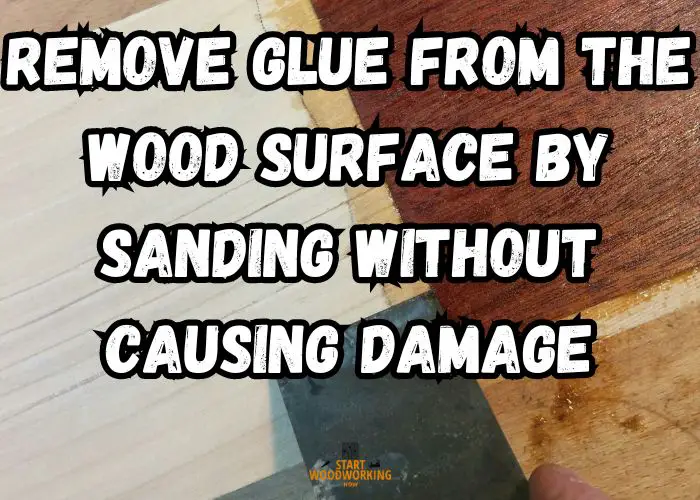
Tools Required
- Sandpaper (150-Grit initially): For sanding off fully dried glue.
- Wooden Block or Sanding Sponge: Provides better control for sanding tight corners or edges.
- Sanding Block: For consistent results on large glued surfaces.
- Clean Cloth: Wipes away remaining dust after sanding.
Steps how to do it:
- Allow the glue to dry completely. This usually takes 24 hours but can vary depending on the type of wood and glue used. Fully dried glue will sand off more easily.
- Begin with 150-grit sandpaper. Fold it in half to create a backer that protects your fingers. Sand in the direction of the wood grain using light, even pressure.
- Focus initially on just the glued areas. You don’t want to remove more wood than necessary. Go slow and check frequently so you don’t sand through the glue into the wood surface.
- As the glue sands away, you may need to change to finer grit (180-220 grit) paper to smooth it out. Again, sand only with the grain to avoid scratch marks.
- For tight corners or edges, wrap the sandpaper around a wooden block or sanding sponge for better control. Renew the paper as it loads up with glue residue.
- Blow or wipe away sanding dust frequently to see your progress. Once the glue is level with the wood, you’re done sanding.
- To prevent scratching, always sand with the grain, using light pressure. Pay extra attention to curves and bevels.
- For large glued surfaces, use a sanding block for consistent results. Change grits as needed until you achieve a smooth surface.
- Wipe away the remaining dust and inspect your work. Re-sand any imperfections before finishing for best results.
| Manual Methods | Advantages | Drawbacks | Best Suited For |
|---|---|---|---|
| Sanding | Effective for unfinished wood Clears clogged wood pores | Requires appropriate sandpaper grit selection Can be time-consuming | Unfinished wood surfaces |
| Scraping | Safe for finished wood surfaces Ideal for removing softened glue Minimal potential for damage with a plastic scraper | May require pre-treatment with heat or solvents Can be less effective on dried glue | Finished wood surfaces and glue softened by heat or solvents |
In conclusion, when opting for manual glue removal, it is crucial to assess the specific needs of your project and the condition of the wood surface. Using the correct technique – sanding for unfinished wood or scraping for finished surfaces and softened glue – will help you minimize potential damage to the wood and achieve a successful outcome.
How to Maintain the Integrity of Wood During Glue Clean-up
Throughout the glue removal process, maintaining the wood’s integrity is key. This means being gentle with physical removal methods and cautious with solvent applications. Restorative steps, such as sanding or refinishing, might be necessary if accidental surface damage does occur.
To ensure proper care during wood glue clean-up, be sure to follow these essential guidelines:
- Test any solvent or heat on a small, inconspicuous area before applying to a larger portion of your project.
- For unfinished wood, use sandpapers with a grit rating between 150 and 180 to remove dried glue while preserving the wood’s original finish.
- Use an orbital sander to make the process more efficient and ensure an even finish.
- For finished wood, employ a hairdryer or heat gun on a low setting to soften the glue without causing damage to the wood or glue.
- When scraping softened glue, opt for a plastic putty knife instead of metal tools to avoid scratches and other damage.
If any damage occurs during the glue removal process, you can take steps to repair it and restore the wood’s appearance. Some of the possible repairing wood glue damage measures are listed below:
- Sanding and refinishing the damaged area using compatible wood varnish or stain.
- Filling any dents or gouges with wood filler before final sanding and refinishing.
- Applying a protective finish to the repaired area to help prevent further damage.
How to Restore Wood Surfaces After Glue Removal
After successfully removing glue from wood, it may be necessary to restore the surface to ensure a smooth and uniform appearance. The approach to restoration differs based on the state of the wood and whether it’s finished or unfinished.
Unfinished Wood Restoration
For restoring unfinished wood surfaces, light sanding might be required to even out the area and eliminate any remaining glue residue. Choose a fine-grit sandpaper such as 220 or 240 to ensure you don’t remove too much material.
- Start with a clean and dry surface.
- Apply gentle pressure using a sanding block or orbital sander and sand until the area is smooth and even.
- Remove dust and debris with a vacuum cleaner or a soft brush.
- Repeat the process if needed until you achieve the desired smoothness.
Finished Wood Restoration
If the glue removal process was performed on a finished wood surface, you might need to touch up the varnish or stain to match the surrounding area and bring back the wood’s original luster. Here are some steps to help you restore the appearance of finished wood:
- Determine the type of finish used on the wood (varnish, lacquer, or polyurethane) and procure the corresponding touch-up product.
- Clean the area to ensure there’s no debris or residue left.
- Apply the touch-up product (stain, varnish, or lacquer) to the affected area using a small brush or applicator and blend it with the surrounding finish.
- Buff or sand the area gently, if necessary, to achieve a seamless finish.
| Restoration Tips | Unfinished Wood | Finished Wood |
|---|---|---|
| Sanding | Ensure the surface is free of debris and residue before applying touch-up products | Sand gently if needed to blend touch-up product |
| Cleaning | Remove dust and debris with a vacuum or soft brush | Ensure the wood surface is free of debris and residue before applying touch-up products |
| Finishing | Use fine-grit sandpaper (220-240) for a smooth result | Apply stain, varnish, or lacquer to match the surrounding area |
By following these steps and using the appropriate restoration methods for unfinished and finished wood, you can ensure a visually appealing result that brings your wood surface back to its original beauty after glue removal.
Conclusion
In conclusion, selecting the appropriate wood glue removal techniques is essential to maintain the integrity of your wood surfaces. Whether you are working with unfinished or finished wood, the right approach can make a significant difference in the final outcome. Remember, patience and gentle methods are crucial in ensuring success without damaging the wood.
Upon completing the glue removal process, it is important to take steps to restore the wood surface. Unfinished wood might require light sanding, while finished surfaces could benefit from touch-up varnish or stain applications. By taking these restorative measures, you can ensure that your woodworking projects look their best after glue removal.
Overall, understanding the different methods involved in wood glue removal and restoration can greatly improve your skills in woodworking, ultimately leading to polished results. With careful attention to detail and a commitment to preserving wood surfaces, you can achieve professional-level work and enhance the longevity of your woodwork projects.
FAQs
The best technique for removing wood glue from unfinished wood is by sanding off the dried adhesive using 150 to 180 grit sandpaper and an orbital sander for efficiency.
For finished wood surfaces, try softening the glue with a hairdryer or a low setting on a heat gun before scraping it off with a plastic putty knife to avoid surface damage.
Selecting a sandpaper grit of 150 or 180 is crucial for removing dried glue without removing excessive wood.
Yes, natural solvents such as vinegar or a mild soap solution can be employed. These solutions may take some time to work but are less likely to damage the wood when used correctly.

